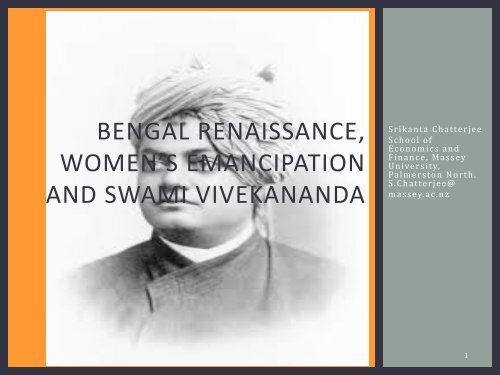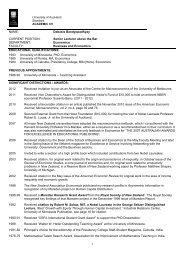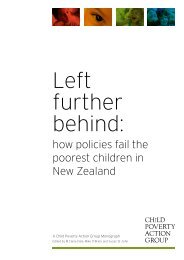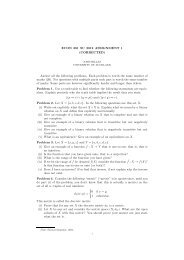bengal renaissance, women's emancipation and swami ... - Economics
bengal renaissance, women's emancipation and swami ... - Economics
bengal renaissance, women's emancipation and swami ... - Economics
Create successful ePaper yourself
Turn your PDF publications into a flip-book with our unique Google optimized e-Paper software.
BENGAL RENAISSANCE,<br />
WOMEN’S EMANCIPATION<br />
AND SWAMI VIVEKANANDA<br />
Srikanta Chatterjee<br />
School of<br />
<strong>Economics</strong> <strong>and</strong><br />
Finance, Massey<br />
University,<br />
Palmerston North.<br />
S.Chatterjee@<br />
massey.ac.nz<br />
1
BENGAL RENAISSANCE<br />
The Historical Background<br />
Ideas of European Enlightenment of the 17 th <strong>and</strong> 18 th centuries<br />
had come to Bengal (to India later) with the advent of British<br />
rule, <strong>and</strong> a wind of change started blowing across the l<strong>and</strong>,<br />
challenging many age-old ideas <strong>and</strong> practices.<br />
The Bengal Renaissance, starting with Raja<br />
Rammohun Roy (1772- 1833), had a social,<br />
economic, cultural <strong>and</strong> religio-spiritual dimension.<br />
All of these dimensions had implications for<br />
women in Bengal (<strong>and</strong> later in the rest of India).<br />
2
RENAISSANCE PERSONALITIES<br />
Some significant 18 th -19 th century Renaissance Personalities<br />
<strong>and</strong> the works they are most remembered for:<br />
Raja Rammohun Roy (1772 – 1833): Abolition of widowimmolation<br />
(satidaho), initiation of the monotheistic,<br />
Upanishad-based Brahmo religion (sect?).<br />
John E. Drinkwater Bethune (1801-51): Women’s<br />
education – founder of Bengal’s first secular girls’<br />
school, The Hindu Balika Vidyalaya, in 1849, with<br />
Vidyasagar as its secretary.<br />
Ishwar Ch<strong>and</strong>ra Vidyasagar (1820-1891): Hindu<br />
widow remarriage, women’s education,<br />
philanthropy, social reform generally.<br />
3
CONTD.<br />
Keshab Ch<strong>and</strong>ra Sen (1838-84):Brahmo Samaj activist,<br />
social reformer, founder of a ‘Universal Religion’.<br />
Debendranath Tagore ( 1817-1905):Ardent Brahmo,<br />
but sought to reconcile it with, <strong>and</strong> accommodate,<br />
some Hindu ritualistic practices.<br />
Sri Ramakrishna (1818-86), religious reformer who,<br />
although himself a priest <strong>and</strong> a practitioner of<br />
orthodox Hindu rituals, asserted that (a) the essential<br />
message of all religions was the same, <strong>and</strong> (b) service<br />
to (suffering) humanity was service to God.<br />
4
CONTD.<br />
Bankim Ch<strong>and</strong>ra Chatterjee (1838- 94): Bangla<br />
language <strong>and</strong> literature, re-affirmation of Sanatan<br />
dharma (orthodox Hindu faith), <strong>and</strong> (Hindu)<br />
patriotic-nationalistic thinking.<br />
Rabindranath Tagore (1861-1941): leading figure<br />
in art <strong>and</strong> literature; educational, social <strong>and</strong><br />
economic thinker <strong>and</strong> activist (reformer)<br />
5
CONTD.<br />
Swami Vivekan<strong>and</strong>a (1863-1902), Vedantist<br />
thinker, social philanthropist, ardent defender of<br />
India’s spiritual legacy <strong>and</strong> founder of the<br />
Ramakrishna order(Math) <strong>and</strong> Mission, the latter<br />
in line with Sri Ramakrishna’s message of<br />
‘service to suffering humanity’.<br />
Sister Nivedita (1867-1911): Women’s education,<br />
social service <strong>and</strong> the Indian nationalist movement.<br />
6
SOME STEPS TOWARD WOMEN EMANCIPATION<br />
IN 19 TH CENTURY BENGAL (LATER INDIA)<br />
Abolition of Suttee (Immolation of Hindus widows), 1829<br />
(Rammohun Roy <strong>and</strong> William Bentinck).<br />
Hindu Widows’ Remarriage Act 1856 (Vidyasagar <strong>and</strong> Canning )<br />
Age of Consent Acts of 1860 (Canning) <strong>and</strong> 1891 (Lansdowne).<br />
Many individual Indians <strong>and</strong> groups had been active in<br />
promoting <strong>and</strong> opposing the ideas on which the law was based.<br />
7
VIVEKANANDA’S THINKING ON WOMEN’S<br />
EMANCIPATION<br />
The Age of Consent Act of 1891, which raised to 12 years the<br />
minimum age at which a girl could be married off, was the first<br />
major event in the area of women’s <strong>emancipation</strong> in India in<br />
Swami Vivekan<strong>and</strong>a’s lifetime. So, his reaction to it is of interest<br />
<strong>and</strong> significance. This is what he observed:<br />
The rulers passed the Age of Consent Bill prohibiting<br />
a man under the threat of penalty for life to live with<br />
a girl of twelve years <strong>and</strong> at once all these so-called<br />
leaders of your religion raised a tremendous hue <strong>and</strong><br />
cry against it, sounding the alarm “alas, our religion<br />
is lost”. As if religion consisted of making a girl a<br />
mother at the age of twelve or thirteen!<br />
8
CONTD.<br />
Vidyasagar died in 1891. There is no record of Vivekan<strong>and</strong>a ever<br />
meeting Vidyasagar in person. Although Vidyasagar’s<br />
achievements are many <strong>and</strong> varied, his reputation as a social<br />
reformer is firmly associated with his success in getting the<br />
Hindu Widows’ Remarriage Act passed, in 1856.<br />
Vivekan<strong>and</strong>a described Vidyasagar as “the hero of<br />
widow remarriage <strong>and</strong> of the abolition of polygamy”<br />
On Vidyasagar’s death, Vivekan<strong>and</strong>a paid tribute to<br />
him with the observation: “there is not a man of my<br />
age in Northern India on whom his shadow has not<br />
fallen”.<br />
9
CONTD.<br />
These comments seemingly reflect Vivekan<strong>and</strong>a’s whole-hearted<br />
support for the major steps taken in the 19 th century toward<br />
women’s <strong>emancipation</strong>.<br />
The women who most influenced Vivekan<strong>and</strong>a:<br />
His mother: Bhuvaneshari Devi (1841-1911)<br />
Holy Mother: Sarada Devi, Sri Ramakrishna’s<br />
spiritual consort (1853-1920).<br />
10
CONTD.<br />
Sister Nivedita (1867 – 1911), his disciple <strong>and</strong> torch-bearer of<br />
Sri Ramakrishna’s message of service to the poor.<br />
The influence of both Sarada Devi <strong>and</strong> Nivedita had<br />
been mostly of a spiritual nature. Only in his<br />
mother’s life had Swami Vivekan<strong>and</strong>a observed the<br />
human aspects of suffering <strong>and</strong> pain, especially as<br />
they affect a widowed Hindu woman. Also, the tragic<br />
incident of one of his sisters, Yogendrabala,<br />
committing suicide had a profound impact on him.<br />
11
VIVEKANANDA’S OWN IDEAS ABOUT WOMEN’S<br />
EMANCIPATION<br />
It would be fair to say that Vivekan<strong>and</strong>a’s scheme of things<br />
regarding the uplift of Indian women was a mixture of<br />
traditional (Hindu) attitude to women in society <strong>and</strong> modern<br />
liberal ideas.<br />
His ideal of Indian womanhood was “Sita, Savitri,<br />
Damayanti”, especially Sita. (“I know that the race<br />
that produced Sita – even if only dreamt of her – has<br />
a reverence for women that is unmatched on earth”).<br />
12
CONTD.<br />
He observed: “the ideal of womanhood in India is motherhood –<br />
that marvellous, unselfish, all-suffering, ever-forgiving mother”. He<br />
considered ‘purity’ <strong>and</strong> ‘chastity’ to be the supreme attributes of a<br />
‘perfect mother’.<br />
[Contrast this idealised view of Indian womanhood<br />
with Vidyasagar’s lament on the daily life of women<br />
in India: let not the unfortunate weaker sex (abala)<br />
be born in a country where the men have no pity, no<br />
dharma, no sense of right <strong>and</strong> wrong, no ability to<br />
discriminate between beneficial <strong>and</strong> harmful. Where<br />
preservation of what has been customary is considered<br />
the only duty, the only dharma …… By what sin do you,<br />
women, come to be born in Bhartavarsha at all?]<br />
13
EDUCATION AS THE PATHWAY TO SOCIAL<br />
UPLIFT FOR WOMEN<br />
“Education”, to Vivekan<strong>and</strong>a “is the manifestation of the<br />
perfection already in man…… Therefore the only duty of the<br />
teacher …. is to remove all obstructions from the way”.<br />
Education was not just gathering <strong>and</strong> storing of<br />
information, but promoter of mental concentration<br />
<strong>and</strong> builder of Character, according to Vivekan<strong>and</strong>a.<br />
“Educate your women first <strong>and</strong> leave them to<br />
themselves; then they will tell you what reforms<br />
are necessary for them”.<br />
14
CONTD.<br />
To Vivekan<strong>and</strong>a, sex discrimination is unfair because “Vedanta<br />
declares that one <strong>and</strong> the same conscious Self is present in all<br />
beings”.<br />
So, while he prescribed “religion, arts, science,<br />
housekeeping, cooking, sewing, hygiene – the simple<br />
essential points in these subjects ought to be taught<br />
to our women”, Vivekan<strong>and</strong>a emphasised religion to be at the<br />
be the centre of female education so that chastity <strong>and</strong>d<br />
loyalty to husb<strong>and</strong> become the principal aims of<br />
educating women.<br />
15
CONTD.<br />
Vivekan<strong>and</strong>a wanted Indian women to have an education that<br />
would create “great fearless women – women worthy to<br />
continue the tradition of Sanghamitra, Lila, Ahalya Bai <strong>and</strong> Mira<br />
Bai – women fit to be mothers of heroes….”.<br />
He reminded his countrymen that ancient India had<br />
produced women philosophers <strong>and</strong> scholars like<br />
Maitreyi <strong>and</strong> Gargi, <strong>and</strong> was capable of producing<br />
similar characters again, with proper education for<br />
women.<br />
16
CONTD.<br />
As a pioneering leader of ‘resurgent India’ Vivekan<strong>and</strong>a’s<br />
championing of India’s ancient glory, above everything else, is<br />
perhaps underst<strong>and</strong>able.<br />
While, on the one h<strong>and</strong>, he rejects a religion that<br />
cannot ‘wipe the widow’s tears’, on the other, he is<br />
less eloquent about allowing women to receive<br />
‘modern education’ that could empower them to be<br />
assertive themselves, without having to be just<br />
chaste <strong>and</strong> loyal to their husb<strong>and</strong>s.<br />
17
CONTD.<br />
Likewise, while he admired Western (American) women <strong>and</strong> was<br />
impressed by ‘the social dignity <strong>and</strong> status’ they enjoyed, he also<br />
spoke of their femininity as being ‘outl<strong>and</strong>ish’.<br />
He observed “every American woman had far better<br />
education than can be conceived of by the majority<br />
of Hindu women. Why cannot we have the same<br />
education? We must”. He however went on to say<br />
“morality <strong>and</strong> spirituality are the things for which<br />
we strive. Our women are not so learned, but they<br />
are more pure”.<br />
18
CONCLUDING OBSERVATIONS<br />
Swami Vivekan<strong>and</strong>a is one of ‘the makers of modern India’.<br />
As a <strong>renaissance</strong> figure, Vivekan<strong>and</strong>a’s contributions to India’s<br />
national life extended beyond religion <strong>and</strong> spirituality with<br />
which his name is perhaps most associated.<br />
He identified education, fitting with India’s culture,<br />
as the way to rejuvenate India’s national life.<br />
19
CONTD.<br />
He was conscious of the low social position Indian women<br />
occupied, <strong>and</strong> emphasised education as the pathway to women’s<br />
<strong>emancipation</strong>.<br />
His prescription for women’s education however<br />
was one that encouraged them to value ‘chastity <strong>and</strong><br />
purity', more than any other aims of education.<br />
While some of his ideas are controversial, he was in<br />
many ways ahead of his time in recognising the<br />
many deficiencies of India’s national life <strong>and</strong><br />
Character. He was fearlessly scathing in criticising<br />
them <strong>and</strong> constructive in seeking solutions to them.<br />
20
In this season of paying tribute to one of modern India’s<br />
greatest thinkers <strong>and</strong> spiritual stalwarts, I do not feel apologetic<br />
being somewhat critical of his thinking in respect of Indian<br />
women’s education <strong>and</strong> <strong>emancipation</strong>. After all, Swamiji<br />
himself taught India to develop a critical outlook<br />
on life.<br />
21









